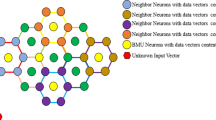Abstract
A set of scaling feedforward filters is developed in an unsupervised way via inputting pixel-discretized extended objects into a winner-take-all artificial neural network. The system discretizes the input space by both position and size. Depending on the distribution of input samples and below a certain number of neurons the spatial filters may form groups of similar filter sizes with each group covering the whole input space in a quasi-uniform fashion. Thus a multi-discretizing system may be formed. Interneural connections of scaling filters are also developed with the help of extended objects. It is shown both theoretically and with the help of numerical simulation that competitive Hebbian learning is suitable for defining neighbours for the multi-discretizing system. Taking into account the neighbouring connections between filters of similar sizes only, i.e. within the groups of filters, the system may be considered as a self-organizing multi-grid system.
Similar content being viewed by others
References
Connolly CI, Grupen RA (1993) On the applications of harmonic functions to robotics. J Robotic Syst 10:931–946
Dyer CL (1987) Multiscale image understanding. In: Parallel computer vision. Academic Press, New York, pp 171–213
Fomin T, Szepesvari C, Lörincz A (1994) Self-organizing neurocontrol. In: Proceedings of the IEEE International Conference on Neural Networks. Orlando, Fla, IEEE Piscataway, pp 2777–2780
Fritzke B (1991) Let it grow — self organizing feature maps with problem dependent cell structure. In: Proceedings of ICANN, vol 1. Elsevier, Amsterdam, pp 403–408
Glasius R, Komoda A, Gielen S (1995) Neural network dynamics for trajectory formation and obstacle avoidance. Neural Networks 8:125–133
Grossberg S (1976) Adaptive pattern classification and universal recoding. I. Parallel development and coding of neural feature detectors. Biol Cybern 23:121–134
Grossberg S (1987) From interaction activation to adaptive resonance theory. Cogn Sci 11:23–63 (and references therein)
Kohonen T (1984) Self organisation and associative memory. Springer, Berlin Heidelberg New York
Lei G (1990) A neuron model with fluid properties for solving labyrinthian puzzle. Biol Cybern 64:61–67
Lund JS (1990) Excitatory and inhibitory circuitry and laminar mapping strategies in the primary visual cortex of the monkey. In: Signal and sense: local and global order in perceptual maps. Wiley, New York
Luttrell SP (1994) A Bayesian analysis of self-organizing maps. Neural Comput 6:767–794
Marczell Z, Kalmár Z, Lörincz A (1996) Generalized skeleton formation for texture segmentation. Neural Network World 6:79–87
Marshall JA (1990) A self-organizing scale-sensitive neural network. In: Proceedings of the International Joint Conference on Neural Networks, San Diego, CA, IEEE Piscataway, vol 3, pp 649–654
Marshall JA (1992) Development of perceptual context-sensitivity in unsupervised neural networks: parsing, grouping, and segmentation. In: Proceedings of the International Joint Conference on Neural Networks, Baltimore, MD, IEEE Piscataway, vol 3, pp 315–320
Martinetz T (1993) Competitive Hebbian learning rule forms perfectly topology preserving maps. In: Proceedings of ICANN. Springer, Berlin Heidelberg New York, pp 427–434
Martinetz T, Schulten K (1991) A ‘neural-gas’ network learns topologies. In: Proceedings of ICANN, vol 1. Elsevier, Amsterdam, pp 397–402
Martinetz T, Schulten K (1994) Topology representing networks. Neural Networks 7:507–522
Obermayer K, Ritter H, Schulten K (1990) A neural network model for the formation of topographic maps in the CNS: development of receptive fields. In: IJCNN-90, Conference Proceedings II. San Diego, IEEE Piscataway, pp 423–429
Ritter H, Obermayer K, Schulten K, Rubner J (1991) Self-organizing maps and adaptive filters. In: Models of neural networks. Springer, Berlin Heidelberg New York, pp 281–307
Rozgonyi T, Fomin T, Lörincz A (1994) Self-organizing scaling filters for image segmentation. In: Proceedings of the IEEE International Conference on Neural Networks, Orlando, Fla, IEEE. Piscataway, vol 7, pp 4380–4383
Szepesvari C, Lörincz A (1993) Topology learning solved by extended objects: a neural network model. In: Proceedings of the World ongress on Neural Networks, vol 2. Erlbaum, Hillsdale, NJ, pp 497–500
Szepesvári C, Balázs L, Lörincz A (1994) Topology learning solved by extended objects: a neural network model. Neural Comput 6:441–458
Author information
Authors and Affiliations
Rights and permissions
About this article
Cite this article
Rozgonyi, T., Balázs, L., Fomin, T. et al. Self-organized formation of a set of scaling filters and their neighbouring connections. Biol. Cybern. 75, 37–47 (1996). https://doi.org/10.1007/BF00238738
Received:
Accepted:
Issue Date:
DOI: https://doi.org/10.1007/BF00238738




